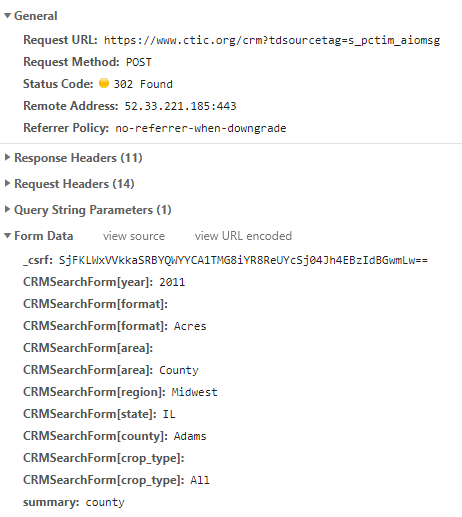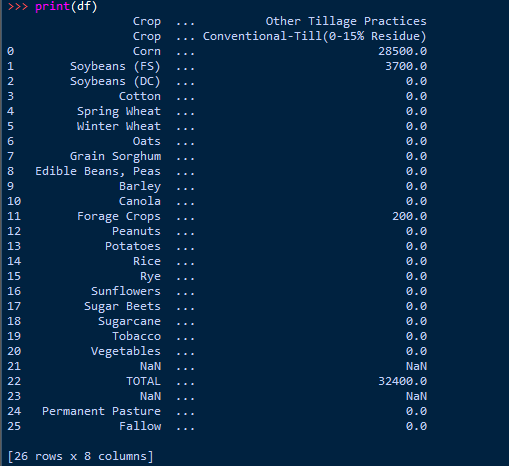
本节主要内容有:
上周五,大师兄发给我一个网址,哭哭啼啼地求我:“去!把这个网页上所有年所有县所有作物的数据全爬下来,存到Access里!”
私信小编001即可获取大量Python学习资料!
我看他可怜,勉为其难地挥挥手说:“好嘞,马上就开始!”
大师兄给我的网址是这个:https://www.ctic.org/crm?tdsourcetag=s_pctim_aiomsg
打开长这样:

根据我学爬虫并不久的经验,通常只要把年月日之类的参数附加到url里面去,然后用requests.get拿到response解析html就完了,所以这次应该也差不多——除了要先想办法获得具体有哪些年份、地名、作物名称,其他部分拿以前的代码稍微改改就能用了,毫无挑战性工作,生活真是太无聊了
点击 View Summary 后出现目标网页长这样

那个大表格的数据就是目标数据了,好像没什么了不起的——
有点不对劲
目标数据所在网页的网址是这样的:https://www.ctic.org/crm/?action=result ,刚刚选择的那些参数并没有作为url的参数啊!网址网页都变了,所以也不是ajax
这和我想象的情况有巨大差别啊
让我来康康点击View Summary这个按钮时到底发生了啥:右键View Summary检查是这样:

实话说,这是我第一次遇到要提交表单的活儿。以前可能是上天眷顾我,统统get就能搞定,今天终于让我碰上一个post了。
点击View Summary,到DevTools里找network第一条:

不管三七二十一,post一下试试看
import requests
url = 'https://www.ctic.org/crm?tdsourcetag=s_pctim_aiomsg'
headers = {'user-agent': 'Mozilla/5.0 (windows NT 10.0; Win64; x64) '
'AppleWebKit/537.36 (KHTML, like Gecko) '
'Chrome/74.0.3729.131 Safari/537.36',
'Host': 'www.ctic.org'}
data = {'_csrf': 'SjFKLWxVVkkaSRBYQWYYCA1TMG8iYR8ReUYcSj04Jh4EBzIdBGwmLw==',
'CRMSearchForm[year]': '2011',
'CRMSearchForm[format]': 'Acres',
'CRMSearchForm[area]': 'County',
'CRMSearchForm[region]': 'Midwest',
'CRMSearchForm[state]': 'IL',
'CRMSearchForm[county]': 'Adams',
'CRMSearchForm[crop_type]': 'All',
'summary': 'county'}
response = requests.post(url, data=data, headers=headers)
print(response.status_code)
果不其然,输出400……我猜这就是传说中的cookies在搞鬼吗?《Python3网络爬虫实战》只看到第6章的我不禁有些心虚跃跃欲试呢!
首先,我搞不清cookies具体是啥,只知道它是用来维持会话的,应该来自于第一次get,搞出来看看先:
response1 = requests.get(url, headers=headers)
if response1.status_code == 200:
cookies = response1.cookies
print(cookies)
输出:
<RequestsCookieJar[<Cookie phpSESSID=52asgghnqsntitqd7c8dqesgh6 for www.ctic.org/>, <Cookie _csrf=2571c72a4ca9699915ea4037b967827150715252de98ea2173b162fa376bad33s%3A32%3A%22TAhjwgNo5ElZzV55k3DMeFoc5TWrEmXj%22%3B for www.ctic.org/>]>
Nah,看不懂,不看不管,直接把它放到post里试试
response2 = requests.post(url, data=data, headers=headers, cookies=cookies)
print(response2.status_code)
还是400,气氛突然变得有些焦灼,我给你cookies了啊,你还想要啥?!
突然,我发现一件事:post请求所带的data中那个一开始就显得很可疑的_csrf我仿佛在哪儿见过?
那个我完全看不懂的cookies里好像就有一个_csrf啊!但是两个_csrf的值很明显结构不一样,试了一下把data里的_csrf换成cookies里的_csrf确实也不行。
但是我逐渐有了一个想法:这个两个_csrf虽然不相等,但是应该是匹配的,我刚刚的data来自浏览器,cookies来自python程序,所以不匹配!
于是我又点开浏览器的DevTools,Ctrl+F搜索了一下,嘿嘿,发现了:

和

这三处。
第一处那里的下一行的csrf_token很明显就是post请求所带的data里的_csrf,另外两个是js里的函数,虽然js没好好学但也能看出来这俩是通过post请求获得州名和县名的,Binggo!一下子解决两个问题。
为了验证我的猜想,我打算先直接用requests获取点击View Summary前的页面的HTML和cookies,将从HTML中提取的csrf_token值作为点击View Summary时post请求的data里的_csrf值,同时附上cookies,这样两处_csrf就应该是匹配的了:
from lxml import etree
response1 = requests.get(url, headers=headers)
cookies = response1.cookies
html = etree.HTML(response1.text)
csrf_token = html.xpath('/html/head/meta[3]/@content')[0]
data.update({'_csrf': csrf_token})
response2 = requests.post(url, data=data, headers=headers, cookies=cookies)
print(response2.status_code)
输出200,虽然和Chrome显示的302不一样,但是也表示成功,那就不管了。把response2.text写入html文件打开看是这样:

Yeah,数据都在!说明我的猜想是对的!那一会再试试我从没用过的requests.Session()维持会话,自动处理cookies。
现在既然已经拿到了目标页面的HTML,那在获取所有年、地区、州名、县名之前,先测试一下pandas.read_html提取网页表格的功能。
pandas.read_html这个函数时在写代码时IDE自动补全下拉列表里瞄到的,一直想试试来着,今天乘机拉出来溜溜:
import pandas as pd
df = pd.read_html(response2.text)[0]
print(df)
输出:

Yeah!拿到了,确实比自己手写提取方便,而且数值字符串自动转成数值,优秀!
接下来要获取所有年、地区、州名、县名。年份和地区是写死在HTML里的,直接xpath获取:

州名、县名根据之前发现的两个js函数,要用post请求来获得,其中州名要根据地区名获取,县名要根据州名获取,套两层循环就行
def new():
session = requests.Session()
response = session.get(url=url, headers=headers)
html = etree.HTML(response.text)
return session, html
session, html = new()
years = html.xpath('//*[@id="crmsearchform-year"]/option/text()')
regions = html.xpath('//*[@id="crmsearchform-region"]/option/text()')
_csrf = html.xpath('/html/head/meta[3]/@content')[0]
region_state = {}
state_county = {}
for region in regions:
data = {'region': region, '_csrf': _csrf}
response = session.post(url_state, data=data)
html = etree.HTML(response.json())
region_state[region] = {x: y for x, y in
zip(html.xpath('//option/@value'),
html.xpath('//option/text()'))}
for state in region_state[region]:
data = {'state': state, '_csrf': _csrf}
response = session.post(url_county, data=data)
html = etree.HTML(response.json())
state_county[state] = html.xpath('//option/@value')
啧啧,使用requests.Session就完全不需要自己管理cookies了,方便!具体获得的州名县名就不放出来了,实在太多了。然后把所有年、地区、州名、县名的可能组合先整理成csv文件,一会直接从csv里读取并构造post请求的data字典:
remain = [[str(year), str(region), str(state), str(county)]
for year in years for region in regions
for state in region_state[region] for county in state_county[state]]
remain = pd.DataFrame(remain, columns=['CRMSearchForm[year]',
'CRMSearchForm[region]',
'CRMSearchForm[state]',
'CRMSearchForm[county]'])
remain.to_csv('remain.csv', index=False)
# 由于州名有缩写和全称,也本地保存一份
import json
with open('region_state.json', 'w') as json_file:
json.dump(region_state, json_file, indent=4)
我看了一下,一共49473行——也就是说至少要发送49473个post请求才能爬完全部数据,纯手工获取的话大概要点击十倍这个数字的次数……
那么开始爬咯
import pyodbc
with open("region_state.json") as json_file:
region_state = json.load(json_file)
data = pd.read_csv('remain.csv')
# 读取已经爬取的
cnxn = pyodbc.connect('DRIVER={Microsoft Access Driver (*.mdb, *.accdb)};'
'DBQ=./ctic_crm.accdb')
crsr = cnxn.cursor()
crsr.execute('select Year_, Region, State, County from ctic_crm')
done = crsr.fetchall()
done = [list(x) for x in done]
done = pd.DataFrame([list(x) for x in done], columns=['CRMSearchForm[year]',
'CRMSearchForm[region]',
'CRMSearchForm[state]',
'CRMSearchForm[county]'])
done['CRMSearchForm[year]'] = done['CRMSearchForm[year]'].astype('int64')
state2st = {y: x for z in region_state.values() for x, y in z.items()}
done['CRMSearchForm[state]'] = [state2st[x]
for x in done['CRMSearchForm[state]']]
# 排除已经爬取的
remain = data.append(done)
remain = remain.drop_duplicates(keep=False)
total = len(remain)
print(f'{total} left.n')
del data
# %%
remain['CRMSearchForm[year]'] = remain['CRMSearchForm[year]'].astype('str')
columns = ['Crop',
'Total_Planted_Acres',
'Conservation_Tillage_No_Till',
'Conservation_Tillage_Ridge_Till',
'Conservation_Tillage_Mulch_Till',
'Conservation_Tillage_Total',
'Other_Tillage_Practices_Reduced_Till15_30_Residue',
'Other_Tillage_Practices_Conventional_Till0_15_Residue']
fields = ['Year_', 'Units', 'Area', 'Region', 'State', 'County'] + columns
data = {'CRMSearchForm[format]': 'Acres',
'CRMSearchForm[area]': 'County',
'CRMSearchForm[crop_type]': 'All',
'summary': 'county'}
headers = {'user-agent': 'Mozilla/5.0 (Windows NT 10.0; Win64; x64) '
'AppleWebKit/537.36 (KHTML, like Gecko) '
'Chrome/74.0.3729.131 Safari/537.36',
'Host': 'www.ctic.org',
'Upgrade-Insecure-Requests': '1',
'DNT': '1',
'Connection': 'keep-alive'}
url = 'https://www.ctic.org/crm?tdsourcetag=s_pctim_aiomsg'
headers2 = headers.copy()
headers2 = headers2.update({'Referer': url,
'Origin': 'https://www.ctic.org'})
def new():
session = requests.Session()
response = session.get(url=url, headers=headers)
html = etree.HTML(response.text)
_csrf = html.xpath('/html/head/meta[3]/@content')[0]
return session, _csrf
session, _csrf = new()
for _, row in remain.iterrows():
temp = dict(row)
data.update(temp)
data.update({'_csrf': _csrf})
while True:
try:
response = session.post(url, data=data, headers=headers2, timeout=15)
break
except Exception as e:
session.close()
print(e)
print('nSleep 30s.n')
time.sleep(30)
session, _csrf = new()
data.update({'_csrf': _csrf})
df = pd.read_html(response.text)[0].dropna(how='all')
df.columns = columns
df['Year_'] = int(temp['CRMSearchForm[year]'])
df['Units'] = 'Acres'
df['Area'] = 'County'
df['Region'] = temp['CRMSearchForm[region]']
df['State'] = region_state[temp['CRMSearchForm[region]']][temp['CRMSearchForm[state]']]
df['County'] = temp['CRMSearchForm[county]']
df = df.reindex(columns=fields)
for record in df.itertuples(index=False):
tuple_record = tuple(record)
sql_insert = f'INSERT INTO ctic_crm VALUES {tuple_record}'
sql_insert = sql_insert.replace(', nan,', ', null,')
crsr.execute(sql_insert)
crsr.commit()
print(total, row.to_list())
total -= 1
else:
print('Done!')
crsr.close()
cnxn.close()
注意中间有个try...except..语句,是因为不定时会发生Connection aborted的错误,有时9000次才断一次,有时一次就断,这也是我加上了读取已经爬取的和排除已经爬取的原因,而且担心被识别出爬虫,把headers写的丰富了一些(好像并没有什么卵用),并且每次断开都暂停个30s并重新开一个会话

然后把程序开着过了一个周末,命令行里终于打出了Done!,到Access里一看有816288条记录,心想:下次试试多线程(进程)和代理池。
周一,我把跑出来的数据发给大师兄,大师兄回我:“好的”。
隔着屏幕我都能感受到滔滔不绝的敬仰和感激之情,
一直到现在,大师兄都感动地说不出话来。